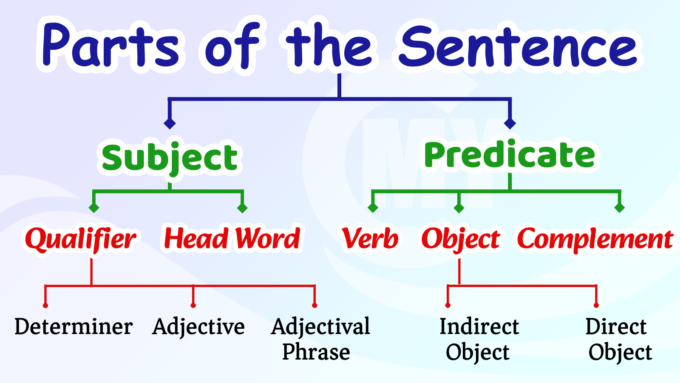In English grammar, a sentence is typically divided into different parts, each serving a specific function. Understanding these parts helps in constructing well-formed sentences and analyzing their structure.
PARTS OF THE SENTENCE
प्रत्येक वाक्य के दो भाग होते हैं-
1. Subject (उद्देश्य)
Subject वाक्य (Sentence) का वह भाग होता है जिसके विषय में वाक्य में बात की जाती हैं; जैसे-
- Ravi bought a book. (रवि ने एक पुस्तक खरीदी।)
- John is reading a book.
उपर्युक्त वाक्यों में, “John” और “Ravi” Subjects हैं, क्योंकि वे खरीदने और पढ़ने की क्रिया कर रहे हैं। Subject को छोड़कर वाक्य का शेष भाग Predicate होता है।
2. Predicate (विधेय)
Predicate वाक्य का वह भाग होता है जो Subject के बारे में बताता है। यह वाक्य के मुख्य क्रिया या अन्य क्रियाओं से मिलकर बना होता है। Predicate में कभी-कभी अन्य शब्द भी शामिल हो सकते हैं, जैसे कि Noun, Pronoun, Adjective, Adverb और क्रिया-विशेषण वाक्यांश (Adverbial Phrases)।
उदाहरण के लिए, वाक्य “The cat is black” में, विषय “cat” है और predicate “is black” है। Predicate बताता है कि बिल्ली का रंग काला है।
वाक्य “The dog is running in the park” में, विषय “dog” है और predicate “is running in the park” है। Predicate बताता है कि कुत्ता पार्क में दौड़ रहा है।
नोट– Subject को छोड़कर वाक्य का शेष भाग Predicate होता है, अर्थात-
Imperative Sentence में Subject छिपा रहता है जो कि प्रायः You होता है; जैसे-
- Thank him. इस वाक्य में भी You छिपा हुआ है।
किन्तु Thank you में I छिपा हुआ है।
- Thank you = I thank you.
प्रायः वाक्य में Subject (उद्देश्य) पहले आता है और विधेय बाद में आता है किन्तु कभी-कभी वाक्य प्रभावपूर्ण बनाने के लिए यह क्रम बदल भी जाता है; जैसे-
- A barking sound the shepherd hears.
- Sweet are the uses of adversity.
FAQs
What is the difference between a subject and a predicate?
The subject is the part of the sentence that performs the action or is being described, answering the question “who” or “what” is doing the action. It typically consists of a noun, pronoun, or noun phrase.
- For example, in the sentence “She ran to the store,” “She” is the subject.
The predicate is the part of the sentence that provides information about the subject or what the subject is doing, answering the question “what happened” or “what is the subject doing.” It includes the verb and any other elements related to the verb.
- For example, in the same sentence “She ran to the store,” “ran to the store” is the predicate.
What is the difference between a direct object and an indirect object?
A direct object is a noun or noun phrase that receives the action of the verb directly, answering the question “whom” or “what” the subject is acting upon.
- For example, in the sentence “She bought a book,” “a book” is the direct object because it is what “she” bought.
An indirect object is a noun or noun phrase that identifies the recipient of the action indirectly, answering the question “to whom” or “for whom” the action is done.
- For example, in the sentence “She gave me a book,” “me” is the indirect object because it is the recipient of the action “gave.”
What is a complement in a sentence?
A complement is a word or group of words that completes the meaning of the sentence. There are two main types of complements:
- Subject complement: This follows a linking verb and renames or describes the subject. For example, in the sentence “She is a doctor,” “a doctor” is the subject complement that renames “she.”
- Object complement: This follows a direct object and provides more information about it. For example, in the sentence “They elected her president,” “president” is the object complement that provides more information about “her,” who is the direct object.
Can a sentence have both a direct object and an indirect object?
Yes, a sentence can have both a direct object and an indirect object. When a sentence contains both, it is referred to as a “double object construction.” For example:
- “She gave him a book.” In this sentence, “him” is the indirect object, and “a book” is the direct object. It answers the questions “to whom” (him) and “what” (a book).
- “They sent me a letter.” Here, “me” is the indirect object, and “a letter” is the direct object. It answers the questions “to whom” (me) and “what” (a letter).
Can you provide an example of a sentence with a subject complement and an object complement?
Let’s construct a sentence that includes both a subject complement and an object complement:
- “The cake tastes delicious.”
In this sentence:
- “The cake” is the subject.
- “tastes” is the linking verb.
- “delicious” is the subject complement. It describes the subject “The cake” and completes the meaning of the sentence.
There is no direct object in this sentence. “Delicious” is not describing an action performed on something else, but rather describing the subject itself.
Additionally, here’s another example of a sentence with both a subject complement and an object complement:
- “They elected Mary president.”
In this sentence:
- “They” is the subject.
- “elected” is the action verb.
- “Mary” is the direct object. It answers the question “whom” they elected.
- “president” is the object complement. It describes the direct object “Mary” and provides additional information about her role after the action.
Remember that subject complements and object complements are different types of complements that serve distinct purposes in a sentence. Subject complements describe the subject and follow linking verbs, while object complements describe the direct object and follow certain action verbs.
